Are you a fan of the spicy and unique flavor created by Korean kimchi?
If so, you may wonder if there’s a substitute for kimchi that doesn’t sacrifice any of its amazing taste. Don’t worry – we have the perfect solution!
In this blog post, we will discuss some fantastic substitutes for kimchi that bring all its beloved flavor without involving fermented cabbage.
We hope that this information offers you an excellent alternative to traditional kimchi! Let’s get started.
What Is Kimchi?
Kimchi is a traditional Korean dish made from fermented vegetables, typically including napa cabbage and radish and seasonings such as garlic, ginger, scallions, and chili peppers.
It can also include other ingredients, such as fish sauce or shrimp paste.
Kimchi is often served as a side dish alongside rice and other main dishes, but it can also be used as an ingredient in soups, stews, and stir-fries.
Kimchi can also be eaten plain or with other toppings such as sesame oil or chopped green onions.
It is known for its pungent flavor but can range from mild to spicy depending on the seasoning ingredients used.
Kimchi is high in vitamins A and C and various other nutrients. It is also rich in lactic acid bacteria and probiotic benefits, making it a healthy food choice.
Kimchi can be made at home or bought pre-made from the store, and it can also be used to make various dishes.

Substitutes For Kimchi
For those who don’t enjoy the taste of kimchi, many substitutes can provide a similar balance of flavor and texture.
Sauerkraut
Sauerkraut can be a substitute for kimchi. It is a fermented cabbage popular for centuries in Eastern Europe, especially Germany.
It is made by shredding cabbage and then allowing it to ferment with salt to create lactic acid.
This process gives sauerkraut its distinct sour flavor.
Sauerkraut can be enjoyed as a side dish or added to soups, stews, salads and sandwiches.
It is often used as an ingredient in Reuben sandwiches, potato pancakes, sauerkraut balls and other delicious dishes.
It can also be served warm or cold, making an excellent topping for hot dogs and bratwursts.
It pairs well with potatoes, pork, sausage and other meats.
Sauerkraut is not only tasty but is also very healthy. It contains vitamins A, C, K and B6 and minerals such as iron and potassium.

Pickled Beets
Pickled beets are a popular condiment and side dish made from boiled or steamed beetroots preserved in brine or vinegar.
This traditional Northern European technique is used to enhance the flavor of beets while also preserving them for longer.
Pickled beets can be served cold as part of salads, sandwiches, and other dishes.
They can also be added to sauces and soups for a tangy flavor boost.
They are also used in traditional recipes, such as borscht or pickle soup.
Pickled beets can be ready-made or made at home with fresh beetroots and simple ingredients like salt, sugar, vinegar, water, spices and herbs.
The pickling process also helps to retain the beets’ nutrition, making them a healthy and delicious addition to any dish.
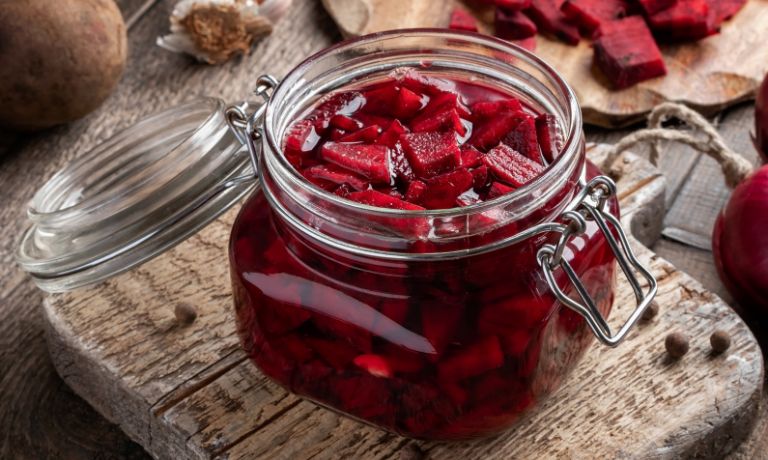
Pickled Cucumbers
You can also use pickled cucumbers to substitute for kimchi.
Pickled cucumbers, also known as dill pickles or gherkins, are cucumbers that have been preserved in a salty brine.
The brine typically contains vinegar, salt herbs and spices such as garlic and dill.
Pickling is one of the oldest methods of preserving food and was originally done to preserve cucumbers for long-term storage.
Pickled cucumbers are a popular addition to salads, sandwiches and burgers.
They can also be used as toppings for tacos or other Mexican dishes.
Pickles make an excellent snack when served with crackers or chips. In some parts of the world, pickled cucumbers are eaten straight from the jar.
Pickled cucumbers can also be used in dishes like pickled salad, fried cucumbers with onion dip, and pickle soup.
They can also be added to stews and casseroles to give them a tart flavor.
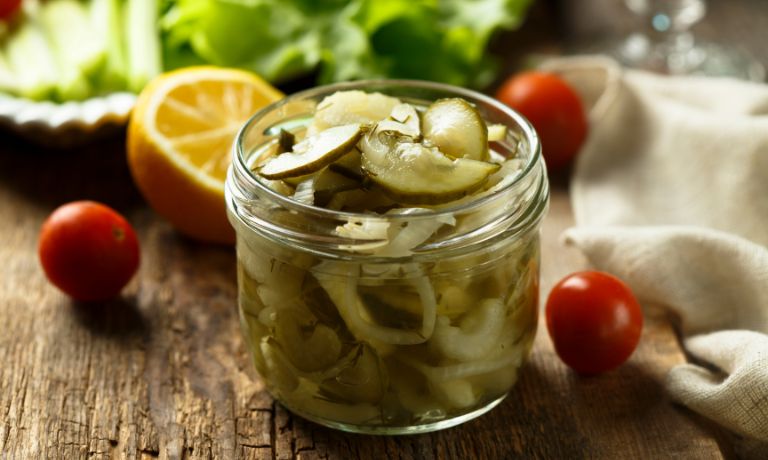
Pickled Jalapenos
Pickled jalapenos are a type of pickle where jalapeno peppers are preserved in vinegar or brine.
They can be served as a condiment to spice up sandwiches, tacos, and salads.
Pickled jalapenos can also be used in cooking for recipes such as nachos, poppers, quesadillas, salsas, and chilis.
They can be added to pizza, pasta, eggs, and other dishes for a flavorful kick.
Pickled jalapenos are also used in marinades and sauces to give them a unique flavor.
The pickling process enhances the natural flavors of the jalapeno peppers while making them milder than their raw counterparts.
Pickled jalapenos are a great way to add flavor and heat to many dishes.
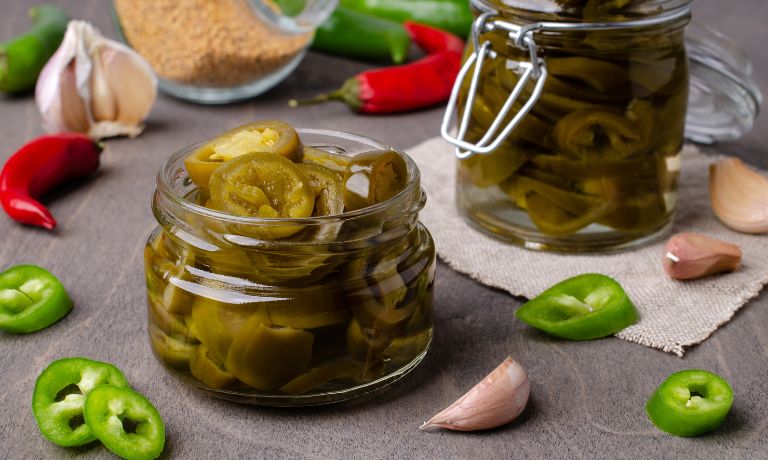
Radish Kimchi
Radish Kimchi is a traditional Korean dish made from daikon radishes fermented with chili peppers, garlic, ginger, and other spices.
Radish Kimchi is an essential ingredient in many Korean dishes and can add a unique and flavorful twist to meals.
It has a spicy-sour flavor and can be served as a condiment or used in stir-fries, soups, stews, and kimchi pancakes.
It can also be used as an accompaniment for grilled meats, such as bulgogi or galbi, and as part of bibimbap.
Additionally, it makes an excellent addition to salads and sandwiches for a spicy kick.
Radish Kimchi is also an excellent source of probiotics, which can help improve overall health.

Tempeh
Tempeh is a fermented soybean product that has become increasingly popular in many parts of the world.
It is made by culturing cooked soybeans with a specific Rhizopus mold, which binds the beans into a dense cake-like form.
Tempeh has a nutty, earthy flavor and chewy texture, making it an ideal meat substitute for vegans and vegetarians.
It can also be used as a high-protein, low-fat addition to recipes for meat eaters.
Tempeh is often marinated before cooking, which helps to give it more flavor and make it more tender.
It can then be cooked in various ways, including baking, grilling, sautéing, or stir-frying.
Tempeh is a great addition to soups and salads and an ingredient in stir-fries, casseroles, veggie burgers, and other vegan and vegetarian dishes.
It can also be crumbled into sauces or used as a topping for tacos, pizzas, and sandwiches.

Kefir
Kefir can also be used to substitute for kimchi. Kefir is a fermented dairy product similar to yogurt in texture and taste.
It can be made using cow’s, goat’s, or sheep’s milk.
It contains a combination of bacteria and yeasts, giving it its unique flavor and consistency.
Kefir is high in protein, calcium, and phosphorus, making it a nutritious addition to the diet.
Kefir can be used in various breakfast, lunch, dinner, or snack recipes. It can be added to smoothies for an extra kick of flavor.
It makes an excellent ingredient in salad dressings and dips when blended with herbs and spices.
It is also used as a substitute for yogurt in baking, making cakes, muffins, and breads moist and flavorful.
Kefir can even be used to make fermented beverages like kefir-ade or kombucha.
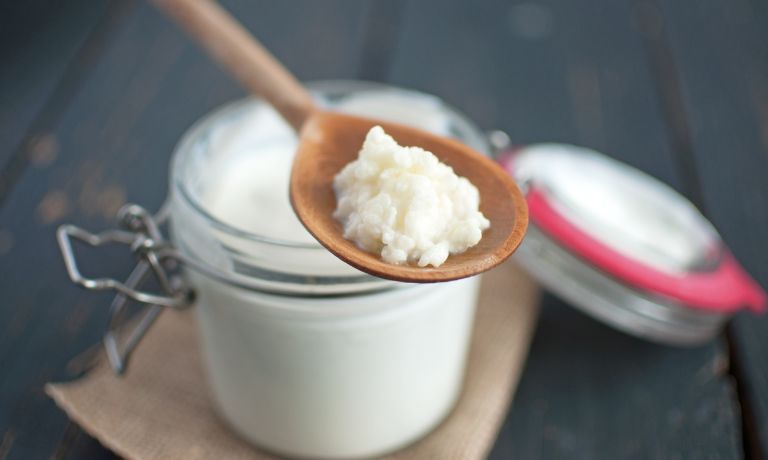
Natto
Natto is a traditional Japanese food made with fermented soybeans.
It is often served as a breakfast dish but can also be used in various recipes.
The unique flavor and texture of the natto make it both flavorful and nutritious, making it an excellent addition to many dishes.
Natto has a strong, slightly sour taste, and its sticky texture can be used to thicken soups and sauces or as a topping for rice dishes.
It is also commonly mixed with other ingredients, such as vegetables, fish, and eggs, to create savory dishes.
Natto has been known to have many health benefits due to its high levels of protein, fiber, vitamins and minerals.
Natto can be enjoyed as a standalone dish or incorporated into other recipes such as stir-fries, soups, and salads.
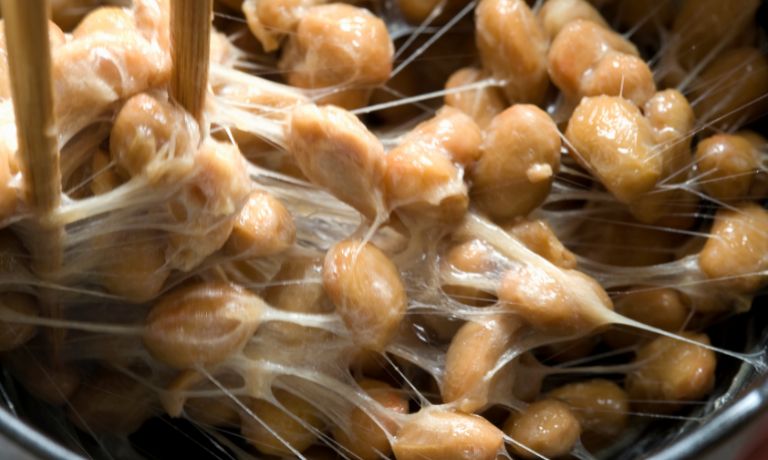
FAQs
Can Kimchi Be Replaced By Sauerkraut?
Yes, sauerkraut can be used as an alternative to kimchi.
The sour and tangy flavor of sauerkraut can mimic that of kimchi, and it also contains probiotics which are beneficial for gut health.
Can Cabbage Replace Kimchi?
Yes, cabbage can be used as an alternative to kimchi.
It is a good substitute for the traditional dish because it has similar health benefits and can be seasoned similarly.
Can Pickled Foods Replace Kimchi?
Yes, pickled foods can be used as an alternative to kimchi.
Pickling vegetables such as cucumbers, radishes, and peppers gives them a sour flavor similar to kimchi and contains beneficial nutrients.
Conclusion
Pickling is an ancient method of preserving food, and it has been used for centuries to make delicious and nutritious dishes.
Pickled vegetables are a great way to add flavor and texture to meals and provide essential nutrients.
Some popular pickled vegetables include beets, cucumbers, jalapenos, radish kimchi, tempeh, kefir, and natto.
Whether you’re looking to substitute for kimchi or create new dishes, pickled vegetables can be used in various recipes for added crunch and flavor.

